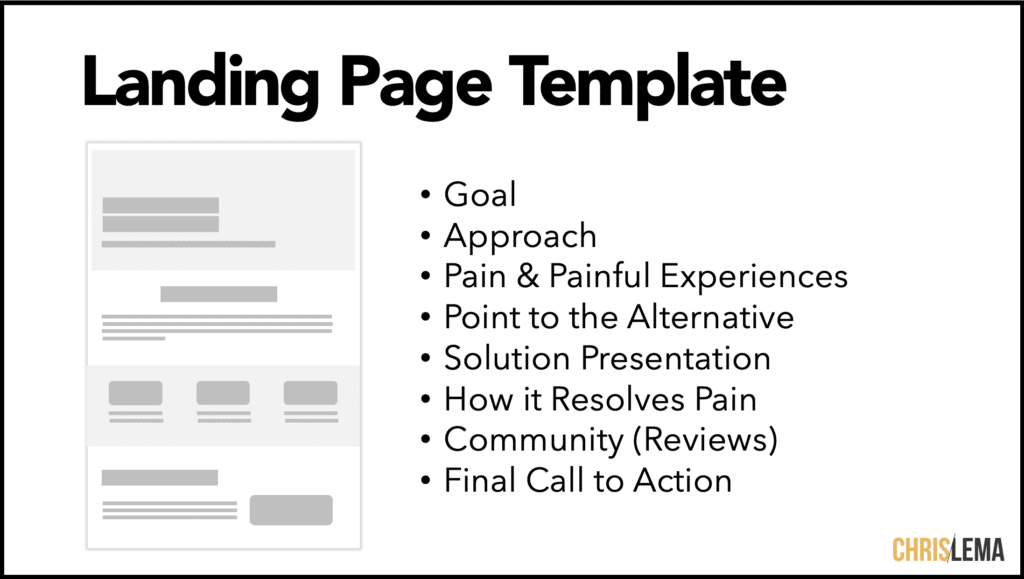Remember When I Wrote about Micro-Segments?
The other day I wrote about ConvertKit and Monday.com and how they crafted different offer pages based on micro-segments. Did you catch that post? I told you it wasn't enough to define a segment. You had to be more precise because it makes building pages for micro-segments so much easier.
Well, today I am going to continue forward with the next logical step – which is how to craft that page, not from a design perspective but from an information architecture dynamic.
What order do you put your content in?
Here's My Offer Page Template
When I am crafting micro-segment offer pages, I use a formula that works for me. You'll notice I'm no artist, so I'm not talking about design. I'm talking about the content on the page, and how it gets ordered.

Let me start by saying that we're not going to write our copy in the same order that we present it. That's often what gets people stuck. So we're going a different route.
And the other thing you need to know is that you only need to craft three stories. That's right – three!
The Three Stories You Need
Here are the three stories you need. I'm not only going to tell you what they are, but I'm going to give you the question you need to answer, in order to shape the story.
The Community Story
This is the first story you are going to work on. I want you to ask yourself these three questions:
- Who is loving our product (or service)?
- Why are they loving it?
- How has it changed their lives?
When you work on this, you realize how powerful it is to look at your offer from the perspective of your existing (and happy customers). We're too often locked into looking at things from our own perspective.
The other thing you might notice is that the list isn't tiny. You have a good amount of happy customers. But you don't always tell their stories. This is a great time to collect a lot of one-liners.
Once you have the answers to these questions, you should be able to craft the community story – which tells prospects how your community appreciates your offering.
The Pain Story
Now the second story is the pain story. That's pretty easy to get now that we've done the community story. What we asked in the community story was how things changed for customers who purchased our offer.
But if we know things changed, we can surely get the “before” version of the story, along with all the random ways our customers tried to fix their problems on their own.
Our three questions are:
- What was life like before you started using our product / service?
- What other options had you tried already?
- What frustrated you the most before you started working with us?
This gets us specific pains. When you're building pages for micro-segments, you need to be really clear that you know their pain and the world they're currently living in.
The only way you get that is when they can see themselves in your copy.
The Goal Story
The last story we work on and collect is all about the destination. Where were people trying to go? My buddy Shawn who runs WP101 has taught me this as a two-pronged question:
- Question: Why do you want to offer this? Answer: Make Money.
- Question: What will you buy with that money? Answer: The Real Goal.
Everyone wants to make (more) money. But that's never the real goal. The real goal rarely gets articulated because we give up too quickly when people give us the answer to the first question.
So now we go back to our customers and ask them what their goal was, when they chose us. And if it's anything like one of these:
- Productivity
- Efficiency
- Profitability
Then we need to push in further to see what exists behind those great answers.
This is hard work and you may have to share some of the answers others have shared with you already to help you get folks to think about this in the right way.
How Does This Help Us Build Micro-Segment Offer Pages?
The good news is that once you have these stories, you have everything you need for great offer pages. The reality is that we still have work to do – but it's not complicated or complex.
First, you may have already noticed that we collected the data in the exact opposite order of how we'll tell our story. It's true. But you've heard people say, “Begin with the end in mind,” right?
Those community stories are great at the end of your page as you're using all those quotes and references as a way to bolster someone's confidence in choosing you. Testimonials are powerful and will always help you convert.
But the top of your offer page should be about the goal story that matches what your prospects want. It helps them self-select (in or out) quickly.
And what sells it is the trust that gets developed as they read the pain stories that you've collected. It helps them see themselves on your page. And know that you've solved it. After all, would you share these pain stories if you didn't have the solution?
Once you assemble these stories in the right order, the last bit of work is adding the parts of my framework above in-between as the links between these sections. But trust me when I tell you that when you get to that point, the copy writes itself.
